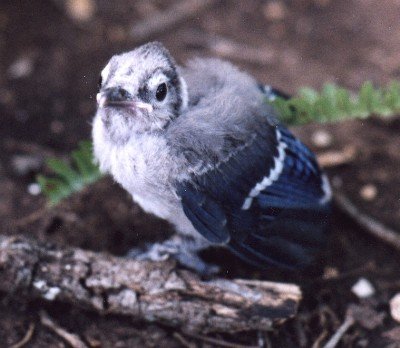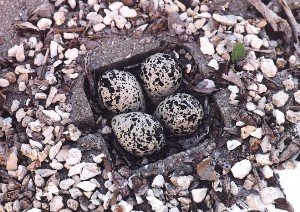More Baby Birds
by Valerie (July 30, 2001)
|
Since writing a previous article on fledgling birds, I've since encountered a few more of the adorable creatures and even managed to photograph a couple.
A totally different kind of bird, killdeer don't visit our yard but are easily observed nearby where we take the dog for walks. Killdeer are a shorebird, or wading bird, and need large, open, flat places to build their nest. Although there is not much water in our area, the birds find the open fields around new shopping centers and other construction to be prime real estate for nesting and feeding. I discovered this little nest in a remote part of a parking lot after almost stepping on the well-camouflaged eggs. I had not even seen either parent bird as they tended to slink off quietly into the surrounding vegetation. Killdeer always lay 4 eggs and don't make a nest as much as just scrape some gravel to make a depression to keep the eggs contained. These birds chose a ready-made nest in one of the concave parts of a drainage tiled area of an otherwise black-topped lot. I thought it was interesting that they still gathered small bits of gravel into a circle around the eggs even though they didn't help with keeping the eggs in place. Perhaps they were for more convincing camouflage.
After discovering the nest, I checked it every time we walked past and the parent sitting on the nest quickly got used to us and just stayed put. Even with the bird on the nest, it was barely visible from even a short distance because of the little bit of vegetation and varied ground patterns. After a couple weeks, I kept my camera handy just in case I happened to be around when the eggs hatched.
One morning, as I approached the nest, I saw one parent bird frantically trying to gather up a couple of babies, while the other parent did the famous "broken wing act." Both birds quickly left the nest area but continued to scream and feign injury in order to lure me away. When I looked closely, it was obvious that the tiny birds had just hatched. They were all still damp but two were already out of the nest and instinctively flattened down less than a foot away. A third was still in the nest, but also remained motionless. One egg was left unbroken but there was no sign of the egg shells from the three that had hatched. I assume the parents removed the shells as soon as the babies emerged. After taking some rapid photos, I left the agitated pair of birds to care for their offspring. Two days later we saw the whole family of two adults and three fluffy little babies running around the parking lot. Evidently, the fourth egg never hatched.
Both these species have adapted well to urbanization, and they perfectly illustrate the difference in chick development between two kinds of birds. Blue jays are altricial and are brooded in a well-constructed nest where they spend their first few weeks. They hatch out as naked, blind, helpless babies that need constant parental care to survive. The adults bring food and protect the young until they are feathered enough to leave the nest. Killdeer, on the other hand, are precocial; emerging feathered, able to see, run and feed themselves very shortly after hatching. They spend more time developing in relatively larger eggs so that they are more advanced when they finally emerge. While the parents still protect them, they don't have to feed them in the short time it takes for the babies to develop their adult plumage and be able to fly. |
 Just a few days ago, I happened to be out in the back yard photographing some plants one evening, when I noticed our dog dashing around even more erratically than usual. There was also a lot of noise from birds so I had to investigate. She was chasing a young blue jay which could not yet fly, and the parents were screaming and squawking from the overhead branches. It was an easy matter to make the dog back off, since my status as dominant female gives me the right to appropriate her prey. When she saw that I wanted her bird, she just ignored us. The feisty little jay alternately attacked and fled, but I managed to get one picture before letting it hide in the vegetation. Blue jays are frequent visitors to our yard and generally chase off other birds around the water dishes. They are also known to sometimes eat other birds' eggs and young, but we have a number of bird species that successfully raise their broods, so this can't be too much of a problem.
Just a few days ago, I happened to be out in the back yard photographing some plants one evening, when I noticed our dog dashing around even more erratically than usual. There was also a lot of noise from birds so I had to investigate. She was chasing a young blue jay which could not yet fly, and the parents were screaming and squawking from the overhead branches. It was an easy matter to make the dog back off, since my status as dominant female gives me the right to appropriate her prey. When she saw that I wanted her bird, she just ignored us. The feisty little jay alternately attacked and fled, but I managed to get one picture before letting it hide in the vegetation. Blue jays are frequent visitors to our yard and generally chase off other birds around the water dishes. They are also known to sometimes eat other birds' eggs and young, but we have a number of bird species that successfully raise their broods, so this can't be too much of a problem.

